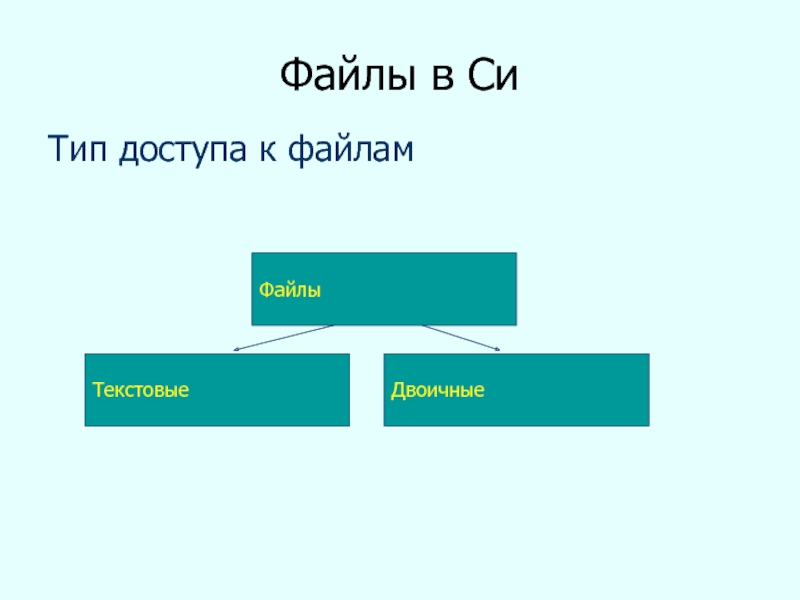- Главная
- Разное
- Дизайн
- Бизнес и предпринимательство
- Аналитика
- Образование
- Развлечения
- Красота и здоровье
- Финансы
- Государство
- Путешествия
- Спорт
- Недвижимость
- Армия
- Графика
- Культурология
- Еда и кулинария
- Лингвистика
- Английский язык
- Астрономия
- Алгебра
- Биология
- География
- Детские презентации
- Информатика
- История
- Литература
- Маркетинг
- Математика
- Медицина
- Менеджмент
- Музыка
- МХК
- Немецкий язык
- ОБЖ
- Обществознание
- Окружающий мир
- Педагогика
- Русский язык
- Технология
- Физика
- Философия
- Химия
- Шаблоны, картинки для презентаций
- Экология
- Экономика
- Юриспруденция
Building Database Applications with JDBC. (Lesson 13) презентация
Содержание
- 1. Building Database Applications with JDBC. (Lesson 13)
- 2. Objectives After completing this lesson, you should
- 3. Using the JDBC API 1 2 3
- 4. Using a Vendor’s
- 5. Key JDBC API Components
- 6. Using a ResultSet Object String
- 7. Putting It All Together package
- 8. Putting It All Together
- 9. Writing Portable JDBC Code The JDBC
- 10. The SQLException Class SQLException can be
- 11. Closing JDBC Objects Connection Statement Statement ResultSet
- 12. The try-with-resources Construct Given the following
- 13. try-with-resources: Bad Practice It might be
- 14. Writing Queries and Getting Results
- 15. ResultSetMetaData There may be a time
- 16. Getting a Row Count A common
- 17. Controlling ResultSet Fetch Size By default,
- 18. Using PreparedStatement PreparedStatement is a subclass
- 19. Using CallableStatement A CallableStatement allows non-SQL
- 20. What Is a Transaction? A transaction is
- 21. ACID Properties of a Transaction A transaction
- 22. Transferring
- 23. Successful
- 24. Unsuccessful Transfer with Transactions Changes within a
- 25. JDBC Transactions By default,
- 26. RowSet 1.1: RowSetProvider and RowSetFactory
- 27. Using RowSet 1.1 RowSetFactory RowSetFactory is used to create instances of RowSet implementations:
- 28. Example: Using JdbcRowSet try (JdbcRowSet
- 29. Data Access Objects Consider an employee table
- 30. The Data Access Object Pattern 1 2 3
- 31. Summary In this lesson, you should have
- 32. Quiz Which Statement method executes a SQL
- 33. Quiz When using a Statement to execute
- 34. Quiz The following try-with-resources statement will
- 35. Quiz Given: String[] params =
Слайд 2Objectives
After completing this lesson, you should be able to:
Define the layout
Connect to a database by using a JDBC driver
Submit queries and get results from the database
Specify JDBC driver information externally
Use transactions with JDBC
Use the JDBC 4.1 RowSetProvider and RowSetFactory
Use a Data Access Object Pattern to decouple data and business methods
Слайд 4
Using a Vendor’s Driver Class
The DriverManager class is used to get
String url = "jdbc:derby://localhost:1527/EmployeeDB";
Connection con = DriverManager.getConnection (url);
The URL syntax for a JDBC driver is:
jdbc:
Each vendor can implement its own subprotocol.
The URL syntax for an Oracle Thin driver is:
jdbc:oracle:thin:@//[HOST][:PORT]/SERVICE
Example:
jdbc:oracle:thin:@//myhost:1521/orcl
Слайд 5
Key JDBC API Components
Each vendor’s JDBC driver class also implements the
java.sql.Connection: A connection that represents the session between your Java application and the database
Connection con = DriverManager.getConnection(url, username, password);
java.sql.Statement: An object used to execute a static SQL statement and return the result
Statement stmt = con.createStatement();
java.sql.ResultSet: A object representing a database result set
String query = "SELECT * FROM Employee";
ResultSet rs = stmt.executeQuery(query);
Слайд 6
Using a ResultSet Object
String query = "SELECT * FROM Employee";
ResultSet rs = stmt.executeQuery(query);
ResultSet cursor
rs.next()
rs.next()
rs.next()
rs.next()
rs.next()
null
The last next() method invocation returns false, and the rs instance is now null.
The first next() method invocation returns true, and rs points to the first row of data.
Слайд 7
Putting It All Together
package com.example.text;
import java.sql.DriverManager;
import java.sql.ResultSet;
import java.util.Date;
public class SimpleJDBCTest {
public static void main(String[] args) {
String url = "jdbc:derby://localhost:1527/EmployeeDB";
String username = "public";
String password = "tiger";
String query = "SELECT * FROM Employee";
try (Connection con =
DriverManager.getConnection (url, username, password);
Statement stmt = con.createStatement ();
ResultSet rs = stmt.executeQuery (query)) {
The hard-coded JDBC URL, username, and password is just for this simple example.
Слайд 8
Putting It All Together
while (rs.next()) {
String first = rs.getString("FirstName");
String last = rs.getString("LastName");
Date birthDate = rs.getDate("BirthDate");
float salary = rs.getFloat("Salary");
System.out.println("Employee ID: " + empID + "\n"
+ "Employee Name: " + first + " " + last + "\n"
+ "Birth Date: " + birthDate + "\n"
+ "Salary: " + salary);
} // end of while
} catch (SQLException e) {
System.out.println("SQL Exception: " + e);
} // end of try-with-resources
}
}
Loop through all of the rows in the ResultSet.
Слайд 9
Writing Portable JDBC Code
The JDBC driver provides a programmatic “insulating” layer
Most databases support a standard set of SQL syntax and semantics described by the American National Standards Institute (ANSI) SQL-92 Entry-level specification.
You can programmatically check for support for this specification from your driver:
Connection con = DriverManager.getConnection(url, username, password);
DatabaseMetaData dbm = con.getMetaData();
if (dbm.supportsANSI92EntrySQL()) {
// Support for Entry-level SQL-92 standard
}
Слайд 10
The SQLException Class
SQLException can be used to report details about resulting
catch(SQLException ex) {
while(ex != null) {
System.out.println("SQLState: " + ex.getSQLState());
System.out.println("Error Code:" + ex.getErrorCode());
System.out.println("Message: " + ex.getMessage());
Throwable t = ex.getCause();
while(t != null) {
System.out.println("Cause:" + t);
t = t.getCause();
}
ex = ex.getNextException();
}
}
Vendor-dependent state codes, error codes and messages
Слайд 11Closing JDBC Objects
Connection
Statement
Statement
ResultSet
ResultSet
close()
Connection
Closes Statements
Invalidates ResultSets
Resources not
released until
next GC
One Way
Better Way
close()
Resources
released
close()
close()
Call
Слайд 12
The try-with-resources Construct
Given the following try-with-resources statement:
try (Connection con =
Statement stmt = con.createStatement();
ResultSet rs = stmt.executeQuery (query)){
The compiler checks to see that the object inside the parentheses implements java.lang.AutoCloseable.
This interface includes one method: void close().
The close method is automatically called at the end of the try block in the proper order (last declaration to first).
Multiple closeable resources can be included in the try block, separated by semicolons.
Слайд 13
try-with-resources: Bad Practice
It might be tempting to write try-with-resources more compactly:
try
However, only the close method of ResultSet is called, which is not a good practice.
Always keep in mind which resources you need to close when using try-with-resources.
Слайд 14
Writing Queries and Getting Results
To execute SQL queries with JDBC, you
Statement stmt = con.createStatement();
Use the Statement instance to execute a SQL query:
ResultSet rs = stmt.executeQuery (query);
Note that there are three Statement execute methods:
Слайд 15
ResultSetMetaData
There may be a time where you need to dynamically discover
int numCols = rs.getMetaData().getColumnCount();
String [] colNames = new String[numCols];
String [] colTypes = new String[numCols];
for (int i= 0; i < numCols; i++) {
colNames[i] = rs.getMetaData().getColumnName(i+1);
colTypes[i] = rs.getMetaData().getColumnTypeName(i+1);
}
System.out.println ("Number of columns returned: " + numCols);
System.out.println ("Column names/types returned: ");
for (int i = 0; i < numCols; i++) {
System.out.println (colNames[i] + " : " + colTypes[i]);
}
Note that these methods are indexed from 1, not 0.
Слайд 16
Getting a Row Count
A common question when executing a query is:
public int rowCount(ResultSet rs) throws SQLException{
int rowCount = 0;
int currRow = rs.getRow();
// Valid ResultSet?
if (!rs.last()) return -1;
rowCount = rs.getRow();
// Return the cursor to the current position
if (currRow == 0) rs.beforeFirst();
else rs.absolute(currRow);
return rowCount;
}
To use this technique, the ResultSet must be scrollable.
Move the cursor to the last row, this method returns false if the ResultSet is empty.
Returning the row cursor to its original position before the call is a good practice.
Слайд 17
Controlling ResultSet Fetch Size
By default, the number of rows fetched at
For example, if you wanted to limit the number of rows fetched into cache to 25, you could set the fetch size:
rs.setFetchSize(25);
Calls to rs.next() return the data in the cache until the 26th row, at which time the driver will fetch another 25 rows.
Слайд 18
Using PreparedStatement
PreparedStatement is a subclass of Statement that allows you to
double value = 100_000.00;
String query = "SELECT * FROM Employee WHERE Salary > ?";
PreparedStatement pStmt = con.prepareStatement(query);
pStmt.setDouble(1, value);
ResultSet rs = pStmt.executeQuery();
In this code fragment, a prepared statement returns all columns of all rows whose salary is greater than $100,000.
PreparedStatement is useful when you have a SQL statements that you are going to execute multiple times.
Substitutes value for the first parameter in the prepared statement.
Parameter for substitution.
Слайд 19
Using CallableStatement
A CallableStatement allows non-SQL statements (such as stored procedures) to
CallableStatement cStmt
= con.prepareCall("{CALL EmplAgeCount (?, ?)}");
int age = 50;
cStmt.setInt (1, age);
ResultSet rs = cStmt.executeQuery();
cStmt.registerOutParameter(2, Types.INTEGER);
boolean result = cStmt.execute();
int count = cStmt.getInt(2);
System.out.println("There are " + count +
" Employees over the age of " + age);
Stored procedures are executed on the database.
The IN parameter is passed in to the stored procedure.
The OUT parameter is returned from the stored procedure.
Слайд 20What Is a Transaction?
A transaction is a mechanism to handle groups
Either all operations in a transaction occur or none occur at all.
The operations involved in a transaction might rely on one or more databases.
Слайд 21ACID Properties of a Transaction
A transaction is formally defined by the
Atomicity: A transaction is done or undone completely. In the event of a failure, all operations and procedures are undone, and all data rolls back to its previous state.
Consistency: A transaction transforms a system from one consistent state to another consistent state.
Isolation: Each transaction occurs independently of other transactions that occur at the same time.
Durability: Completed transactions remain permanent, even during system failure.
Слайд 22
Transferring Without Transactions
Successful transfer (A)
Unsuccessful transfer (Accounts are left in an
$1000
+$100
$1100
$500
-$100
$400
2) Deposit: $100
1) Withdraw: $100
Transfer: $100
From: Acct 1
To: Acct 2
ATM
Account 1
Account 2
$1000
$500
-$100
$400
1) Withdraw: $100
Transfer: $100
From: Acct 1
To: Acct 2
ATM
A
B
Failed
Deposit
Bank
Bank
Account 1
Account 2
Слайд 23
Successful Transfer with Transactions
Changes within a transaction are buffered. (A)
If a
$1100
$400
Commit
Transfer
Successful
Commit
$1000
+$100
$1100
$500
-$100
$400
2) Deposit: $100
1) Withdraw: $100
Transfer: $100
From: Acct 1
To: Acct 2
ATM
Account 1
Account 2
A
Bank
Transaction Started by Bank
Account 1
Account 2
ATM
B
Bank
Transaction Started by Bank
Слайд 24Unsuccessful Transfer with Transactions
Changes within a transaction are buffered. (A)
If a
$500
-$100
$400
1) Withdraw: $100
Transfer: $100
From: Acct 1
To: Acct 2
ATM
Account 1
Account 2
A
Bank
Transaction Started by Bank
$1000
Failed
Deposit
$1000
$500
Rollback
Error Message
Rollback
ATM
B
Bank
Transaction Started by Bank
Account 1
Account 2
Слайд 25
JDBC Transactions
By default, when a Connection is created, it is in
Each individual SQL statement is treated as a transaction and automatically committed after it is executed.
To group two or more statements together, you must disable auto-commit mode.
con.setAutoCommit (false);
You must explicitly call the commit method to complete the transaction with the database.
con.commit();
You can also programmatically roll back transactions in the event of a failure.
con.rollback();
Слайд 26
RowSet 1.1: RowSetProvider and RowSetFactory
The JDK 7 API specification introduces the
javax.sql.rowset.RowSetProvider is used to create a RowSetFactory object:
myRowSetFactory = RowSetProvider.newFactory();
The default RowSetFactory implementation is:
com.sun.rowset.RowSetFactoryImpl
RowSetFactory is used to create one of the RowSet 1.1 RowSet object types.
Слайд 27Using RowSet 1.1 RowSetFactory
RowSetFactory is used to create instances of RowSet
Слайд 28
Example: Using JdbcRowSet
try (JdbcRowSet jdbcRs =
RowSetProvider.newFactory().createJdbcRowSet())
jdbcRs.setUrl(url);
jdbcRs.setUsername(username);
jdbcRs.setPassword(password);
jdbcRs.setCommand("SELECT * FROM Employee");
jdbcRs.execute();
// Now just treat JDBC Row Set like a ResultSet object
while (jdbcRs.next()) {
int empID = jdbcRs.getInt("ID");
String first = jdbcRs.getString("FirstName");
String last = jdbcRs.getString("LastName");
Date birthDate = jdbcRs.getDate("BirthDate");
float salary = jdbcRs.getFloat("Salary");
}
//... other methods
}
Слайд 29Data Access Objects
Consider an employee table like the one in the
By combining the code that accesses the database with the “business” logic, the data access methods and the Employee table are tightly coupled.
Any changes to the table (such as adding a field) will require a complete change to the application.
Employee data is not encapsulated within the example application.
Слайд 31Summary
In this lesson, you should have learned how to:
Define the layout
Connect to a database by using a JDBC driver
Submit queries and get results from the database
Specify JDBC driver information externally
Use transactions with JDBC
Use the JDBC 4.1 RowSetProvider and RowSetFactory
Use a Data Access Object Pattern to decouple data and business methods
Слайд 32Quiz
Which Statement method executes a SQL statement and returns the number
stmt.execute(query);
stmt.executeUpdate(query);
stmt.executeQuery(query);
stmt.query(query);
Слайд 33Quiz
When using a Statement to execute a query that returns only
True
False
Слайд 34
Quiz
The following try-with-resources statement will properly close the JDBC resources:
try
ResultSet rs = stmt.executeQuery(query)){
//...
} catch (SQLException s) {
}
True
False
Слайд 35
Quiz
Given:
String[] params = {"Bob", "Smith"};
String query = "SELECT itemCount
"WHERE lastName='?' AND firstName='?'";
try (PreparedStatement pStmt = con.prepareStatement(query)) {
for (int i = 0; i < params.length; i++)
pStmt.setObject(i, params[i]);
ResultSet rs = pStmt.executeQuery();
while (rs.next()) System.out.println (rs.getInt("itemCount"));
} catch (SQLException e){ }
Assuming there is a valid Connection object and the SQL query will produce at least one row, what is the result?
Each itemCount value for customer Bob Smith
Compiler error
A run time error
A SQLException
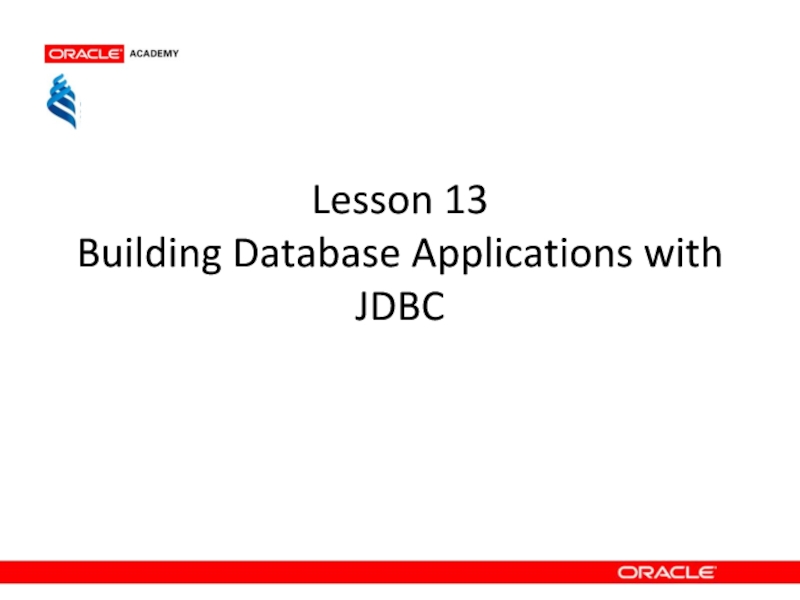
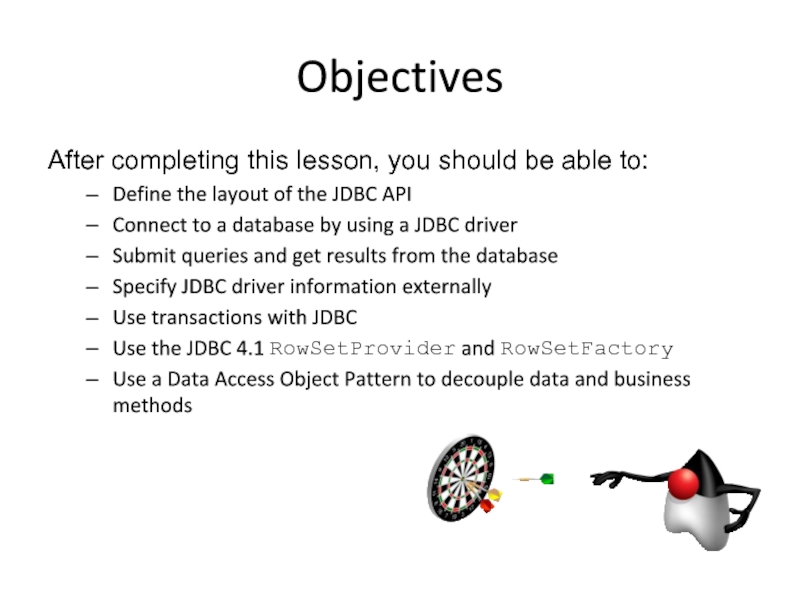
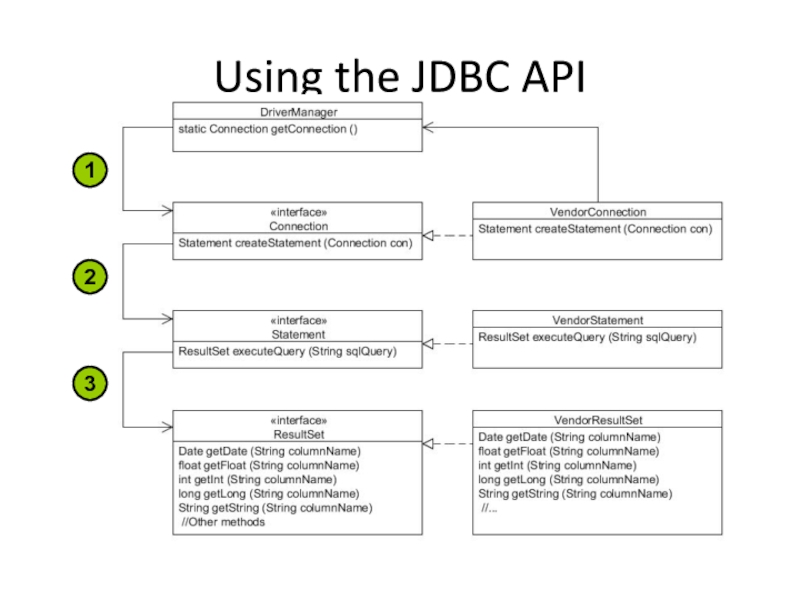
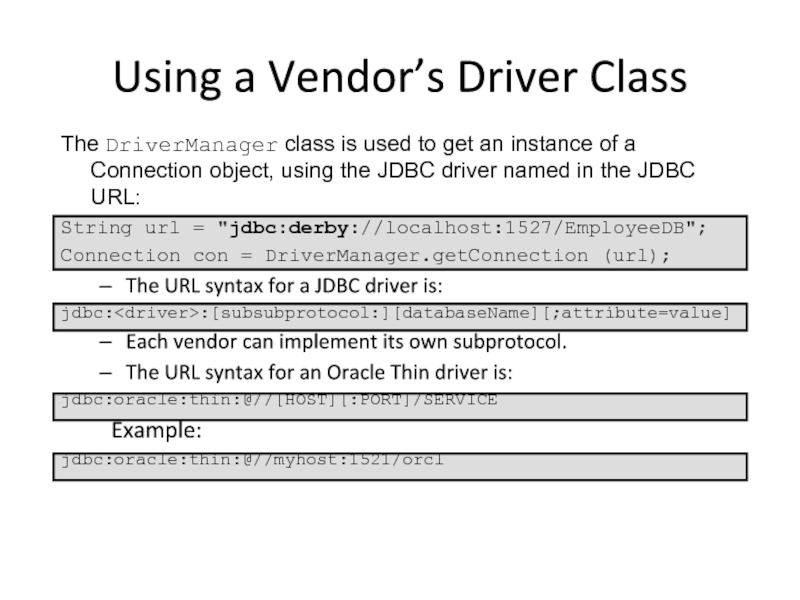
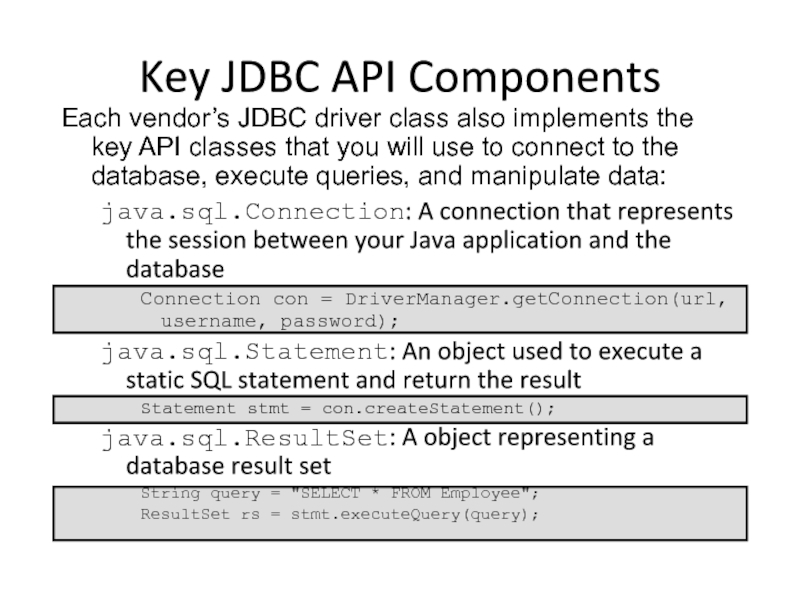
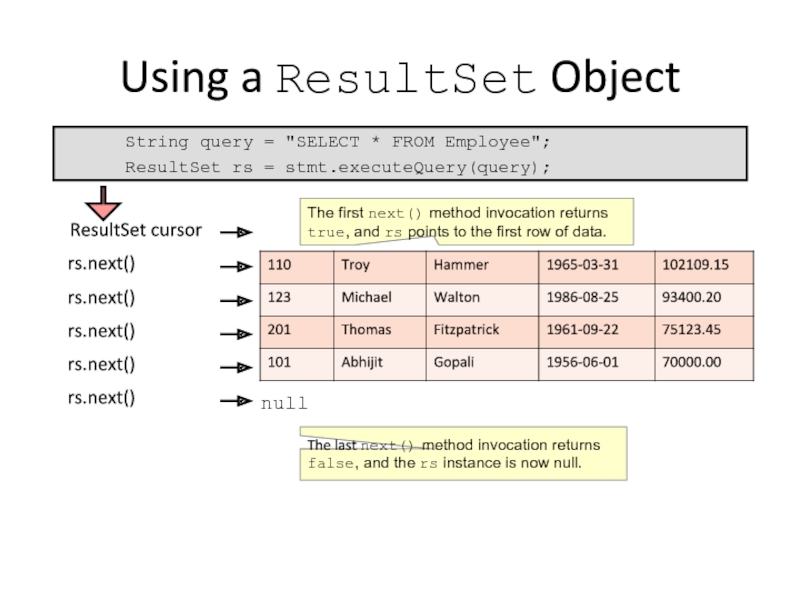
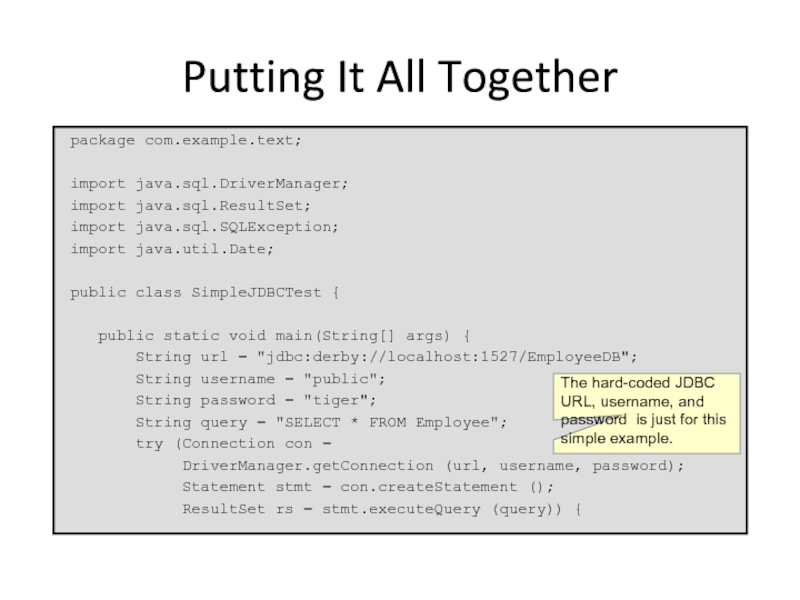
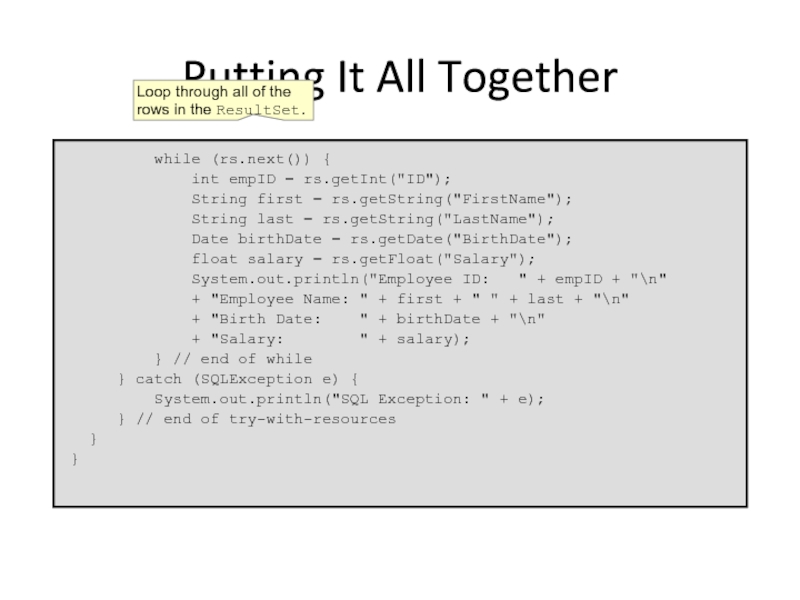
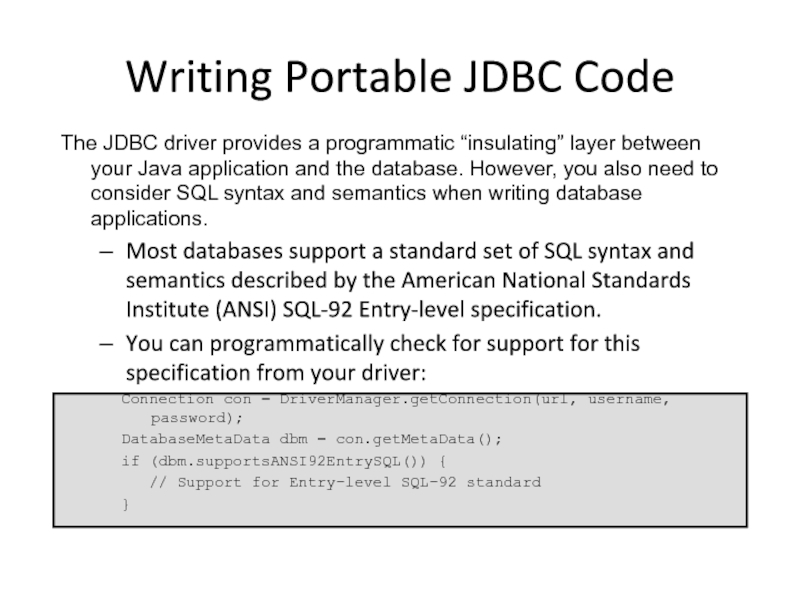
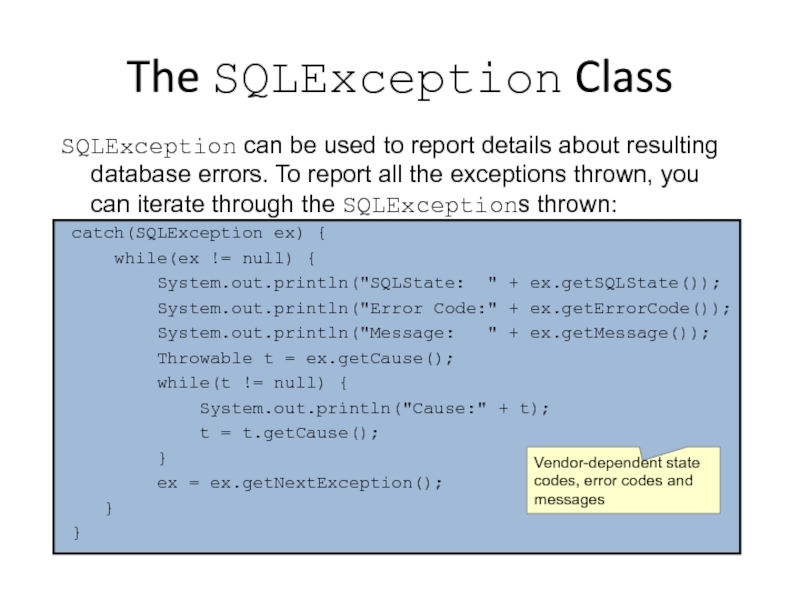
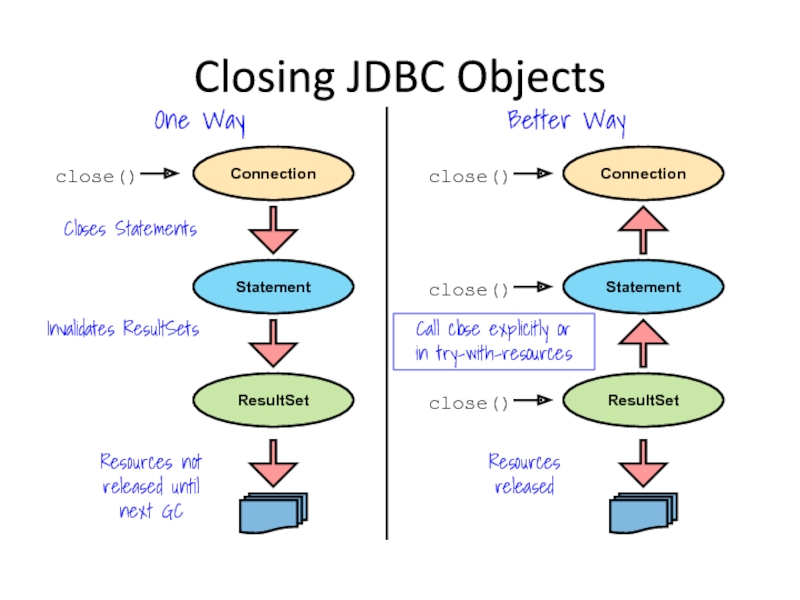
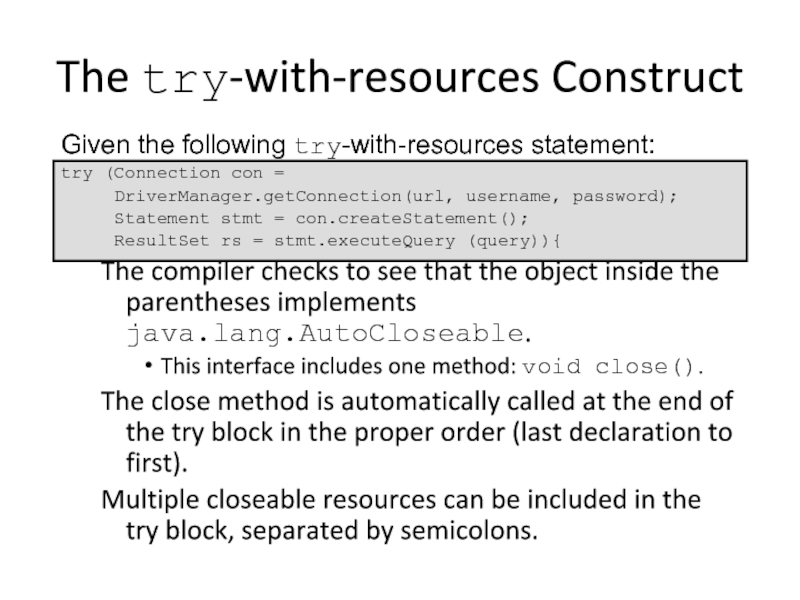
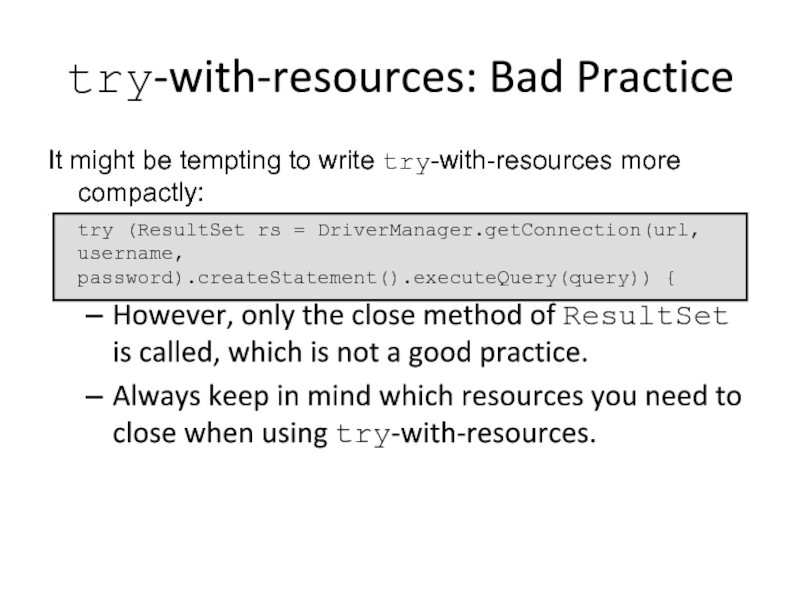
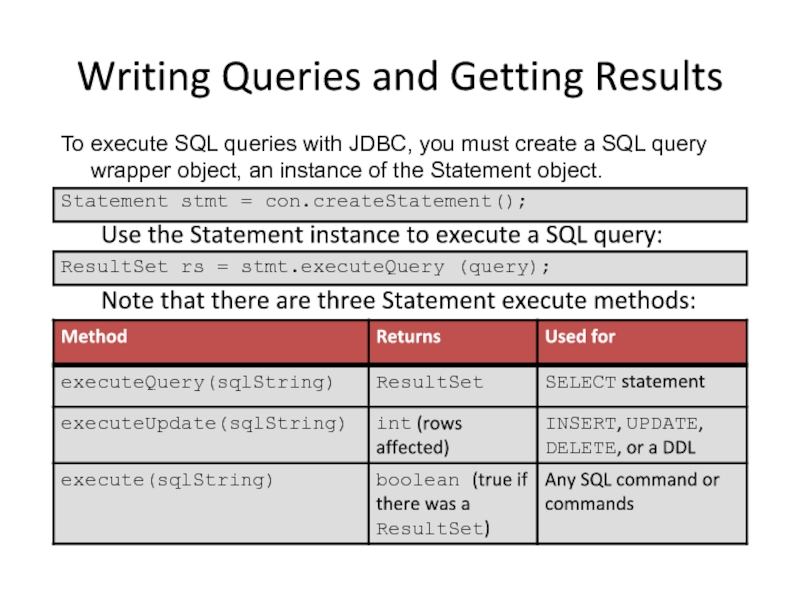
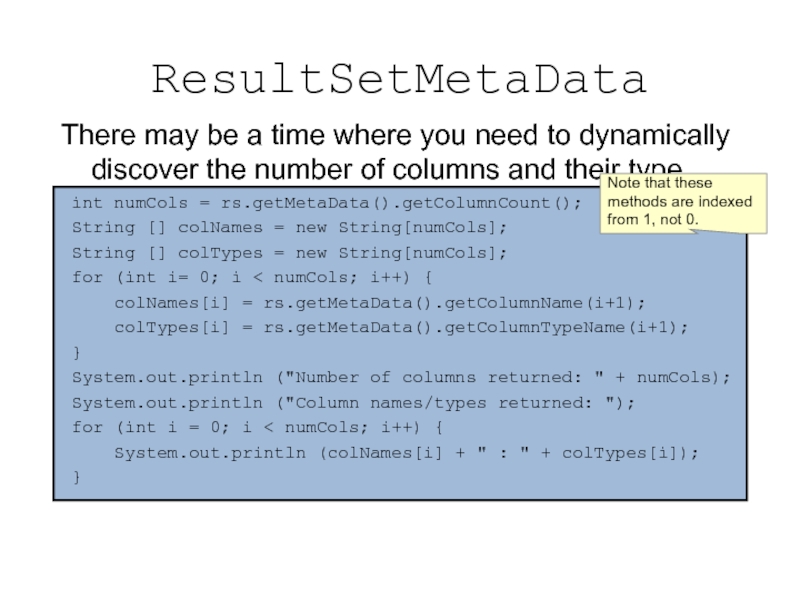
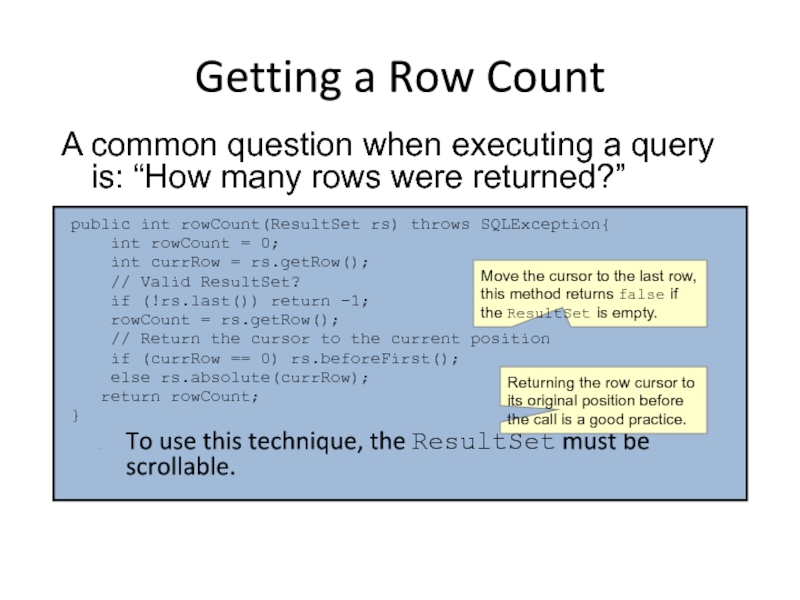
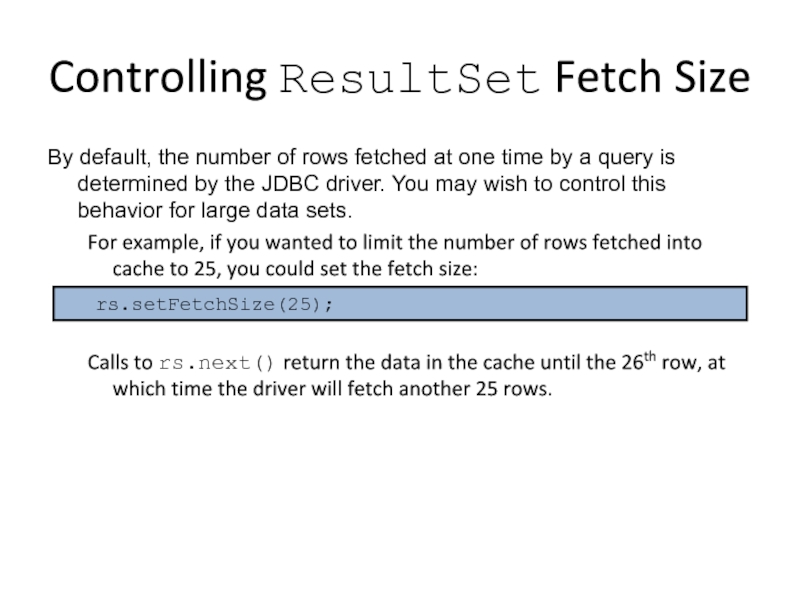
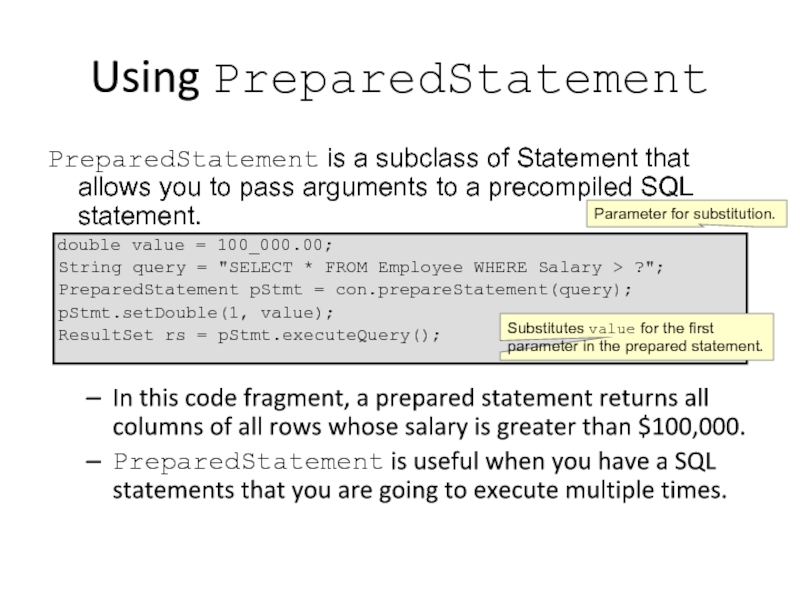
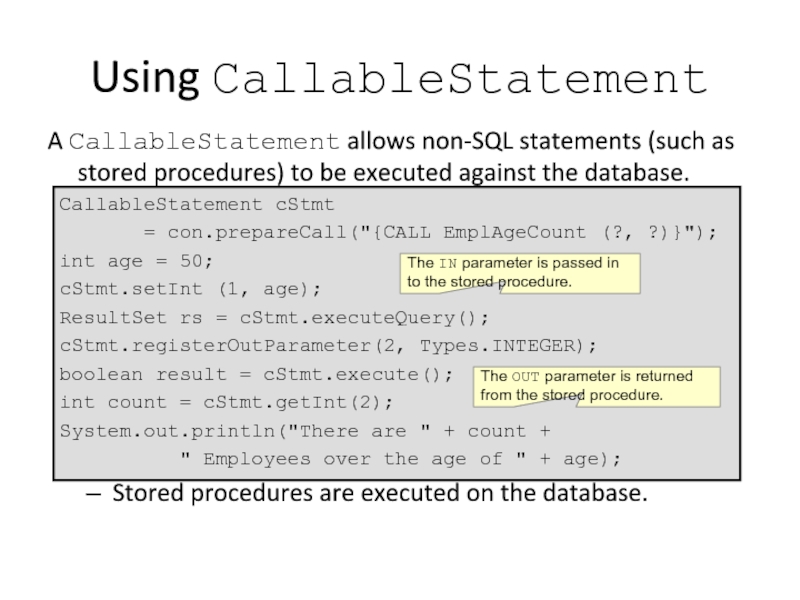
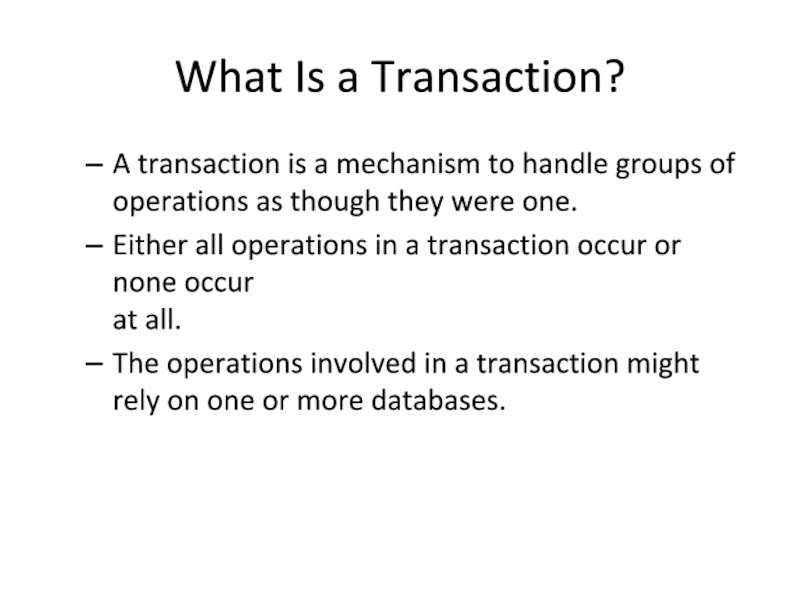
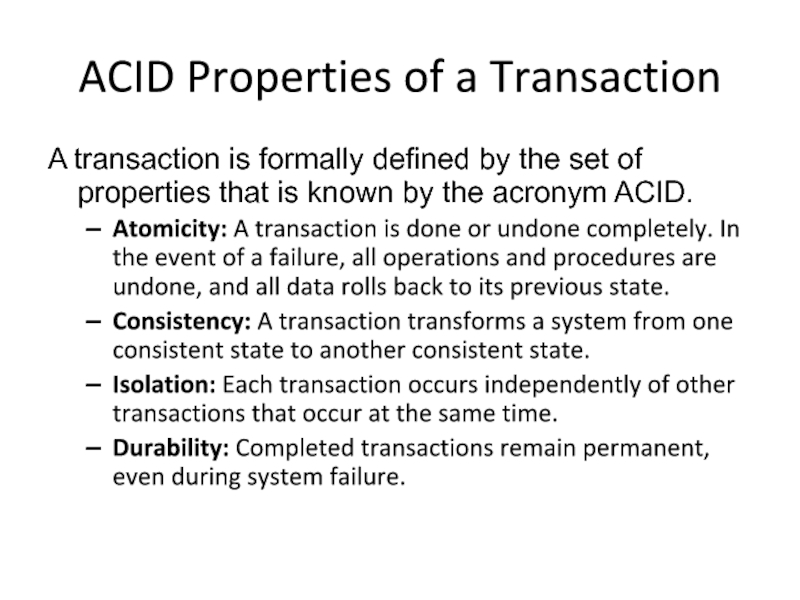
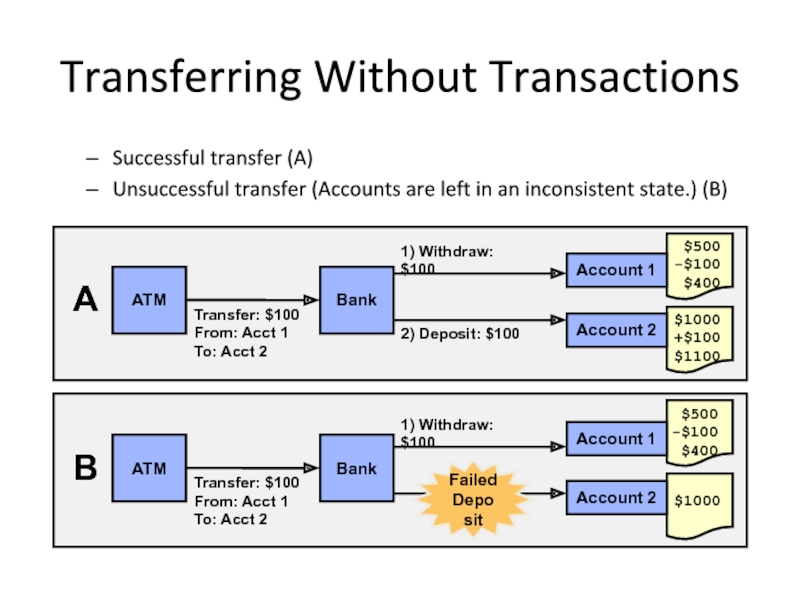
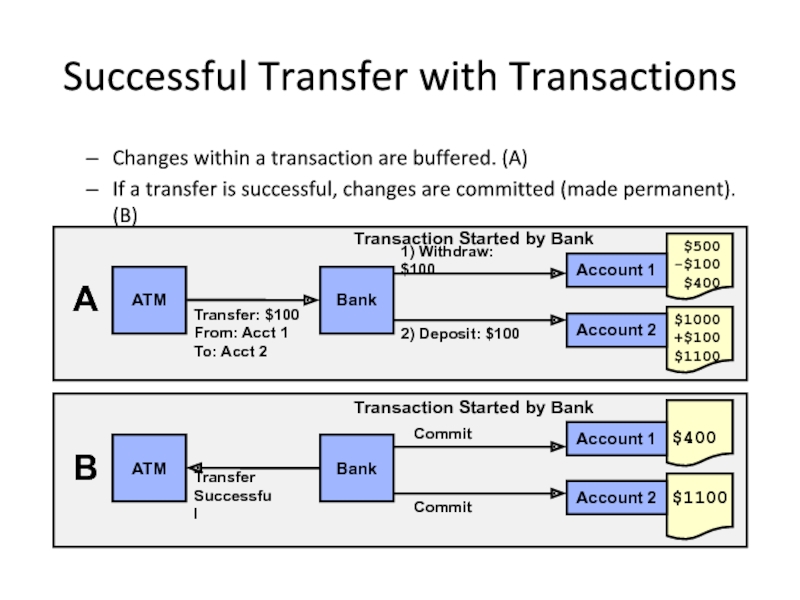
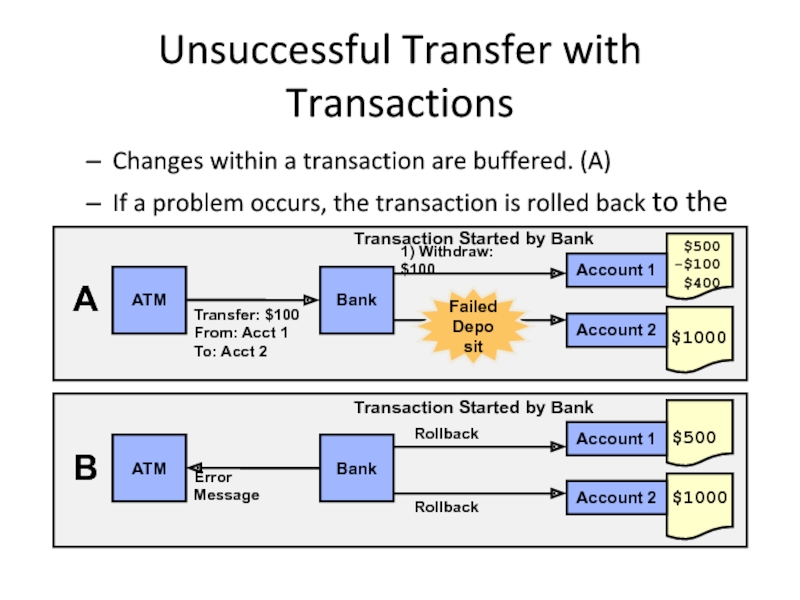
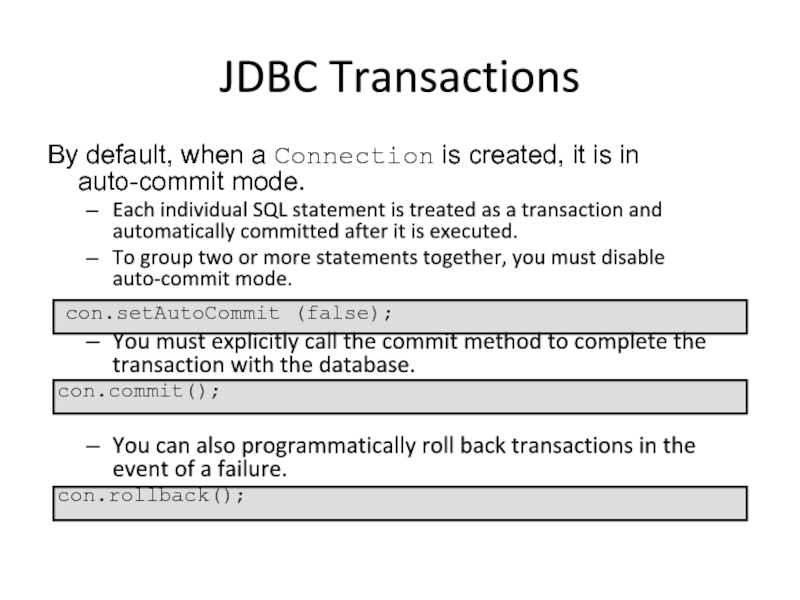
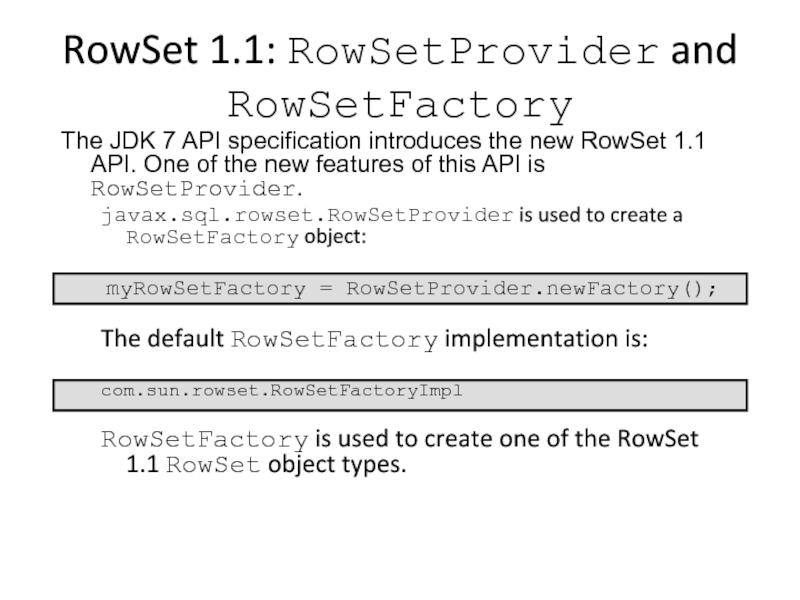
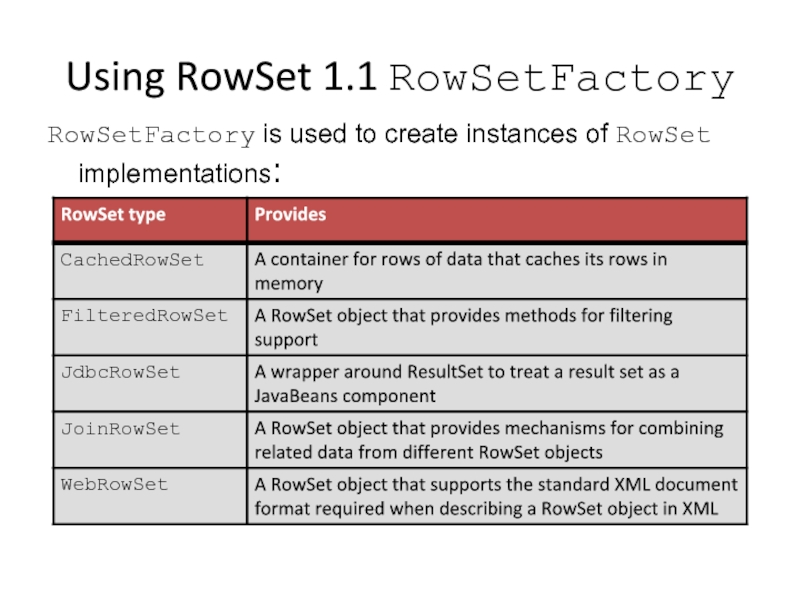
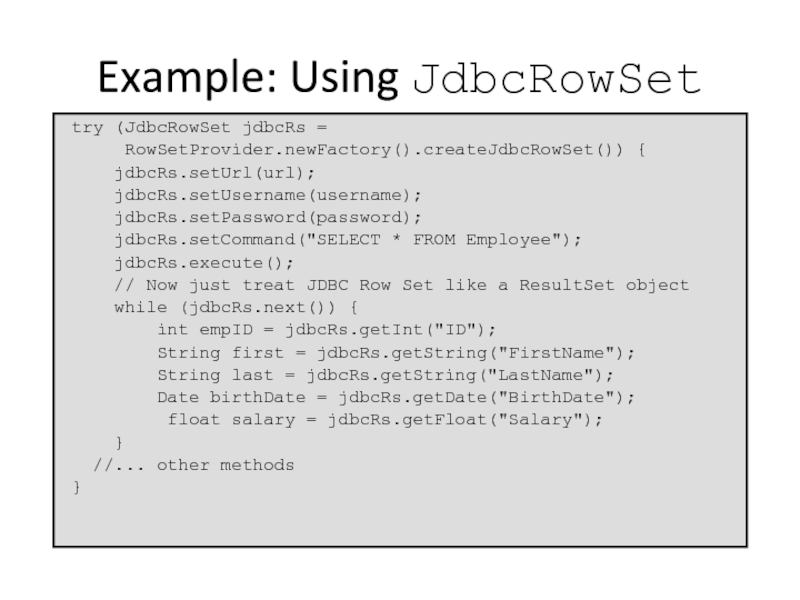
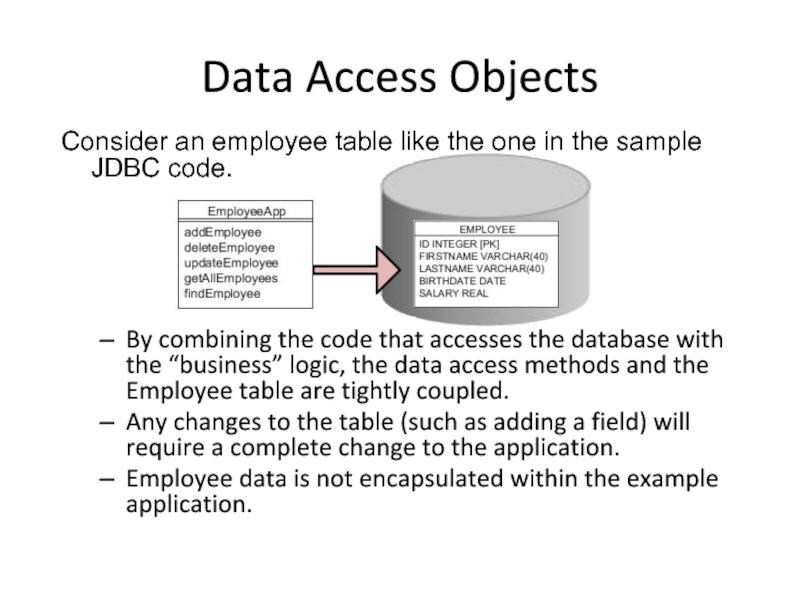
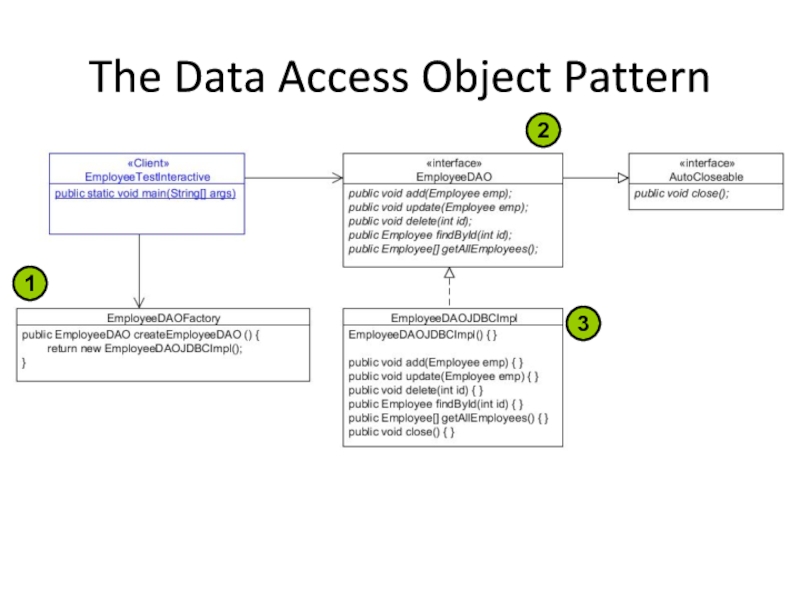
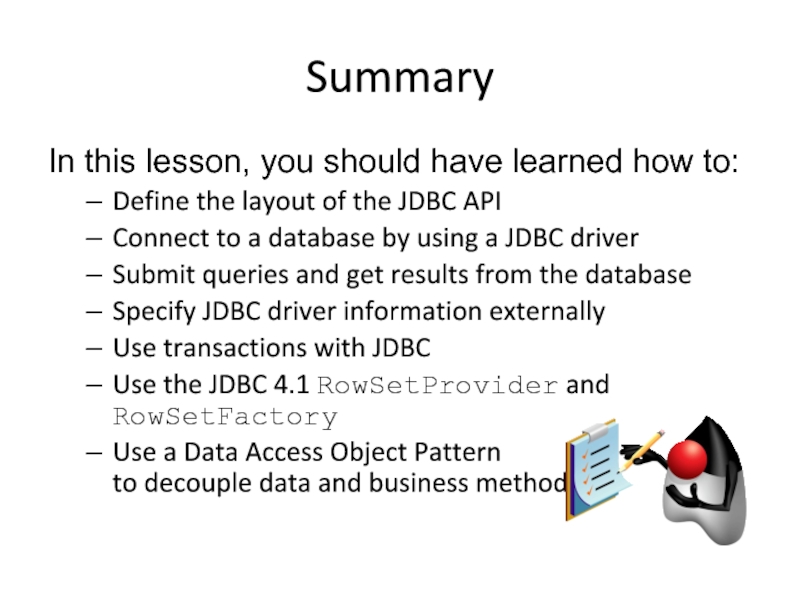
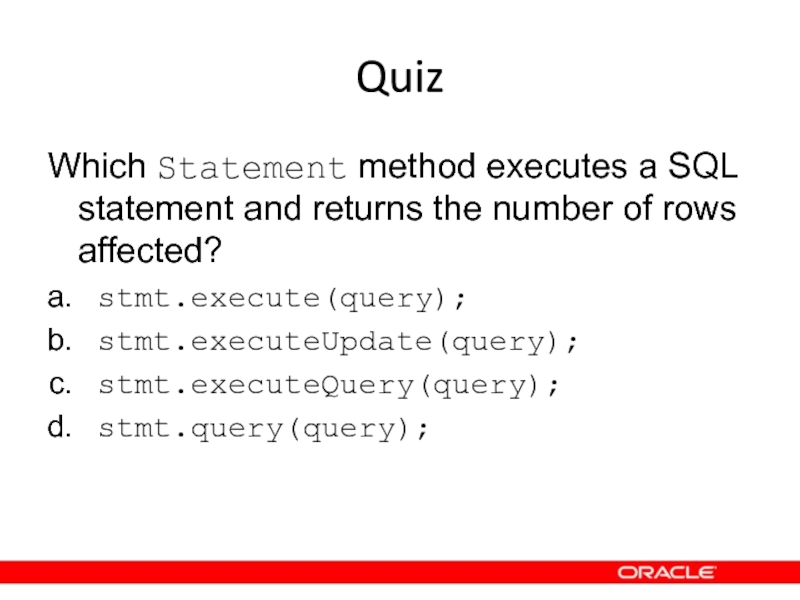
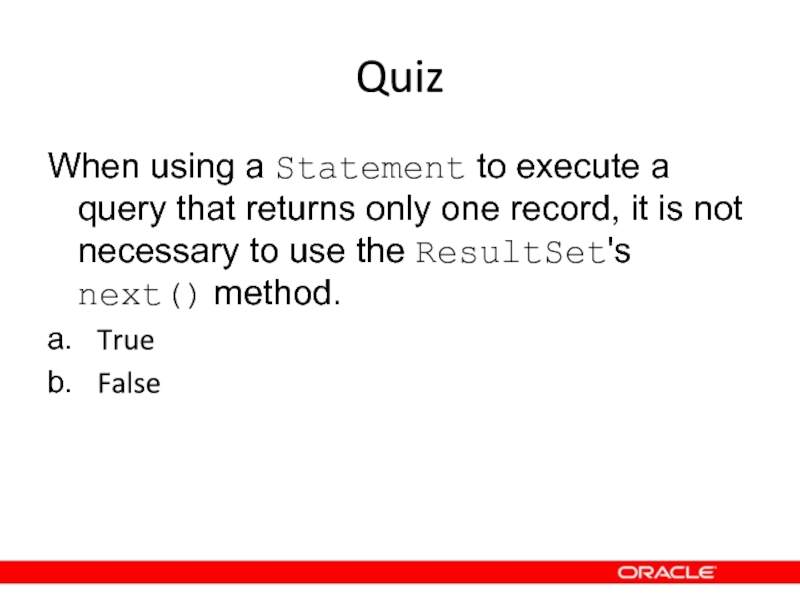
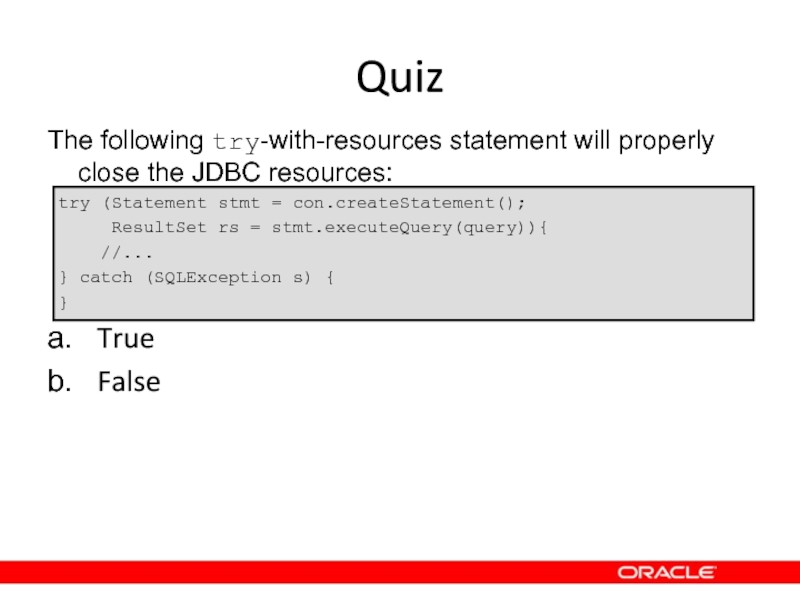
![QuizGiven: String[] params = {](/img/tmb/5/412232/303b32a7062e352794002cecac3891a0-800x.jpg)



